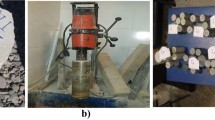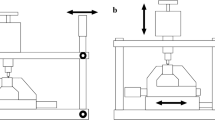Abstract
Forty-six rock units selected from various locations of Pakistan comprising of igneous, sedimentary and metamorphic rocks were subject to a comprehensive laboratory testing program consisting of two parts. The first part included CERCHAR abrasivity tests and measurement of physical rock properties including uniaxial compressive strength (UCS), Brazilian tensile strength (BTS), dry density, porosity, and P-wave velocity (V p). The second part involved petroghraphic thin section analyses of 40 selected abrasive and non-abrasive rock samples along with the determination of wear factors such as Schimazek’s F value and Rock Abrasivity Index (RAI). The CERCHAR abrasivity tests were conducted on sawn (CAIs) and freshly broken (CAIfb) rock surfaces employing top and side viewing methods for the measurement of wear flat of the stylus tip. This paper statistically confirms the previous work on the influence of wear flat measurement methods and rock surface conditions on the CERCHAR Abrasivity Index (CAI) values. It was found statistically that CAIs and CAIfb values measured from top view of the test stylus were 17 and 19 % higher, respectively, in comparison to CAIs and CAIfb values measured using side viewing stylus measurement technique. Further the correlations of CAI with RAI, Schimazek’s F value, petrographic, and physico-mechanical rock properties are also discussed.








Similar content being viewed by others
References
Abu Bakar MZ (2006) A critical review of rock abrasivity measurement methods. M.Sc. Dissertation, University of Leeds
Abu Bakar MZ, Gertsch LS (2012) Radial pick cutting performance in dry and saturated sandstone. Soc Min Metall Explor 332:396–405
AFNOR (2000) Determination du pouvoir abrasive d’une roche-Partie 1: Essai de rayure avec une pointe (NF P 94-430-1) Paris
AL-Ameen SI, Waller MD (1994) The influence of rock strength and abrasive mineral content on the Cerchar Abrasivity Index. Eng Geol 36:293–301
Alber M (2008) Stress dependency of the Cerchar abrasivity index (CAI) and its effects on wear of selected rock cutting tools. Tunn Undergr Space Technol 23:351–359
Alber M, Yarali O, Dahl F, Bruland A, Kasling H, Michalakopoulos TN, Cardu M, Hagan P, Aydm H, Ozarslan A (2014) ISRM suggested method for determining the abrasivity of rock by the CERCHAR abrasivity test. Rock Mech Rock Eng 47:261–266
ASTM-D4543 (2008) Standard practices for preparing rock core as cylindrical test specimens and verifying conformance to dimensional and shape tolerances. Amer Soc Test Mater Int 1–9. doi:10.1520/D4543-08
ASTM-D7625-10 (2010) Standard test method for laboratory determination of abrasiveness of rock using the CERCHAR method. Amer Soc Test Mater Int 1–6. doi:10.1520/D7625-10
Atkinson T, Cassapi VB, Singh RN (1986a) Assessment of abrasive wear resistance potential in rock excavation machinery. Int J Min Geol Eng 3:151–163
Atkinson T, Denby B, Cassapi VB (1986b) Problems associated with rock material properties in surface mining equipment selection. Trans Inst Min Metall Section A Miner Ind 95:A80–A86
Bisschop F (1991) The analysis of a laboratory cutting and abrasion test to be applied in rock cutting dredging. Classified internal report, Memoirs of the Centre for Engineering Geology in the Netherlands. Delft University of Technology, pp 81–105
Bruland A (2000) Hard rock tunnel boring. PhD. Dissertation, vol. 3, Advance rate and cutter wear, Norwegian University of Sciences and Technology of Trondheim (NTNU), Report No. 1B-98
CERCHAR (1986) Centre d’Etudes et des Recherches des Charbonages de France. The CERCHAR abrasiveness index, CERCHAR, Verneuil
Deketh HJR (1991) Determination of optimum conditions for the modified pin-on-disc test. Mem Cent Eng Geol Neth 85:27
Deliormanli AH (2012) Cerchar abrasivity index (CAI) and its relation to strength and abrasion test methods for marble stones. Constr Build Mater 30:16–21
Dipova N (2012) Investigation of the relationships between abrasiveness and strength properties of weak limestone along a tunnel route. J Geol Eng 36:23–34
Fowell RJ, Abu Bakar MZ (2007) A review of the Cerchar and LCPC rock abrasivity measurement methods. In Proceeding of the 11th Congress of the International Society for Rock Mechanics 155–160
Gharahbagh EA, Rostami J, Ghasemi AR, Tonon F (2011) Review of rock abrasion testing. In: Proceeding of the 45th US Rock Mechanics/Geomechanics Symposium, pp 11–141
Ghasemi AR (2010) Study of Cerchar abrasivity index and potential modifications for more consistent measurement of rock abrasion. M.Sc. Dissertation, Pennsylvania State University
Hair JF, Black WC, Babin BJ, Anderson RE (2009) Multivariate data analysis, 7th edn. Prentice Hall, Newyork
Hamzaban MT, Memarian H, Rostami J (2013) Continuous monitoring of pin tip wear and penetration into rock surface using a new Cerchar abrasivity testing device. Rock Mech Rock Eng. doi:10.1007/s00603-013-0397-4
Hamzaban MT, Memarian H, Rostami J, Ghasemi-Monfared H (2014) Study of rock-pin interaction in Cerchar abrasivity test. Int J Rock Mech Min Sci 72:100–108
ISRM (1978a) Suggested methods for determining tensile strength of rock materials. Int J Rocks Mech Min Sci Geomech 15:99–103
ISRM (1978b) Suggested methods for determining sound velocity. Int J Rocks Mech Min Sci Geomech 15:53–58
ISRM (1979a) Suggested methods for determining the uniaxial compressive strength and deformability of rock materials. Int J Rocks Mech Min Sci Geomech 16:135–140
ISRM (1979b) Suggested methods for determining water content, porosity, density, absorption and related properties and swelling and slake-durability index properties. Int J Rocks Mech Min Sci Geomech 16:141–156
Jaeger W (1988) An investigation into the abrasive capacity of rock. Mem Cent Eng Geol Neth 52:99
Johnson ST, Fowell RJ (1986) Compressive strength is not enough (assessing pick wear for drag tool-equiped machines). In: Proceedings of the 27th US Symposium Rock Mechanics, Tuscaloosa, Ala., USA, pp 840–845
Kahraman S, Alber M, Fener M, Gunaydin O (2010) The usability of Cerchar abrasivity index for the prediction of UCS and E of Misis Fault Breccia: regression and artificial neural analysis. Expert Syst Appl 37:8750–8756
Karakus M, Kumral M, Kilic O (2005) Predicting elastic properties of intact rocks from index tests using multiple regression modeling. Int J Rocks Mech Min Sci Geomech 42:323–330
Kasling H, Thuro K (2010) Determining abrasivity of rock and soil in the laboratory. In 11th IAEG Congress. Auckland. New Zealand, 1973–1980, p 235
Kennedy P (2008) A guide to econometrics, 6th edn. Willey Blackwell, Oxford
Khandelwal M, Ranjith PG (2010) Correlating index properties of rocks with P-wave measurements. J Appl Geophys 71:1–5
Labas M, Krepelka F, Ivanicova L (2012) Assessment of abrasiveness for research of rock cutting. Acta Montan Slovaca 1:65–73
Lyman R, Longnecker M (2010) An introduction to statistical methods and data analysis, 6th edn. Brooks/Cole Cengage Learning, Canada
Michalakopoulos TN, Anagnostou VG, Bassanou ME, Panagiotou GN (2006) The influence of steel styli hardness on the Cerchar abrasiveness index value. Int J Rock Mech Min Sci 43:321–327
Muftuoglu YV (1983) A study of factors affecting diggability in British surface coal mines. PhD. Dissertation, University of Nottingham
Paschen D (1980) Petrographic and geomechanical characterization of Ruhr area carboniferous rocks for the determination of their wear behavior. PhD dissertation, Technische Unversitat Claustahl 202
Plinninger RJ (2002) Klassifizierung und Prognose von Werkzeugverschleiß bei konventionellen Gebirgslösungsverfahren im Festgestein. Münchner Geologische Hefte, Reihe B—Angewandte Geologie 17:147
Plinninger RJ, Kasling H, Thuro K, Spaun G (2003) Testing conditions and geomechanical properties influencing the CERCHAR abrasiveness index (CAI) value. Int J Rock Mech Min Sci 40:259–263
Plinninger RJ, Kasling H, Thuro K (2004) Wear prediction in hard rock excavation using the CERCHAR Abrasiveness Index (CAI). In: Proceeding of the EUROCK and 53rd Geomechanics Colloquium, Schubert, pp 599–604
Rostami J, Ozdemir L, Bruland A, Dahl F (2005) Review of issues related to Cerchar abrasivity testing and their implications on Geotechnical investigations and cutter cost estimates. In: Proceedings of the RETC, pp 738–751
Rostami J, Ghasemi AR, Gharahbagh EA, Dogruoz C, Dahl F (2013) Study of dominant factors affecting Cerchar Abrasivity Index. Rock Mech Rock Eng. doi:10.1007/s00603-013-0487-3
Samaranayake VA (2009) Statistical data analysis. STAT-353 course, Missouri University of Science and Technology, Rolla, MO, USA
Schimazek J, Knatz H (1970) The assessment of the cuttability of rocks by drag and roller bits. Ertzmetall 29:113–119
Schumacher L (2004) Auslegung und Einsatzbedingungen von Tunnelvortriebsmaschinen im Hartgestein. Felsbau, 22. Essen (Glückauf) 3:21–28
Singh RN, Hassani FP, Elkington PJ (1983) The application of strength and deformation index testing to the stability assessment of coal measures excavation. In: Proceeding of the 24th US Symposium of Rock Mechanics, pp 599–609
Stanford J, Hagan P (2009) An assessment of the impact of stylus metallurgy on Cerchar abrasiveness index. In: Proceedings of the coal operators conference, pp 348–355
Suana M, Peters T (1982) The cerchar abrasivity index and its relation to rock mineralogy and petrography. Rock Mech 15:1–7
US Army Corps of Engineers. http://www.wes.army.mil/SL/MTC/handbook/RT/RTH/116-95.pdf. Accessed 15 May 2010
Verhoef PNW (1993) Abrasivity of Hawkesbury sandstone (Sydney, Australia) in relation to rock dredging. Q J Eng Geol Hydrol 26:5–17
Verhoef PNW (1997) Wear of rock cutting tools (Implications for the site investigation of rock dredging projects). Balkema, A.A
Verhoef PNW, Vanden Bold HJ, Vermeer ThWM (1990) Influence of microscopic structure on the abrasivity of rock as determined by the pin-on-disc test. In: Proceedings 6th International Congress IAEG, Amsterdam, pp 495–504
West G (1981) A Review of Rock abrasiveness testing for tunnelling. In Proceedings of international symposium on weak rock, Tokyo, 21–24 September, pp 585–594
West G (1986) A relation between abrasiveness and quartz content for some Coal Measures sediments. Int J Min Geol Eng 4:73–78
West G (1989) Rock abrasiveness testing for tunneling. Int J Rock Mech Min Sci Geomech Abstr 26:151–160
Yarali O, Yasar E, Bacak G, Ranjith PG (2008) A study of rock abrasivity and tool wear in coal measures rocks. Int J Coal Geol 74:53–66
Yilmaz NG, Yurdakul M, Goktan RM (2007) Prediction of radial bit cutting force in high-strength rocks using multiple linear regression analysis. Int J Rock Mech Min Sci 44:962–970
Zum Gahr KH (1987) Microstructure and wear of metals. Elsevier, Amsterdam, pp 560
Author information
Authors and Affiliations
Corresponding author
Rights and permissions
About this article
Cite this article
Majeed, Y., Abu Bakar, M.Z. Statistical evaluation of CERCHAR Abrasivity Index (CAI) measurement methods and dependence on petrographic and mechanical properties of selected rocks of Pakistan. Bull Eng Geol Environ 75, 1341–1360 (2016). https://doi.org/10.1007/s10064-015-0799-5
Received:
Accepted:
Published:
Issue Date:
DOI: https://doi.org/10.1007/s10064-015-0799-5




